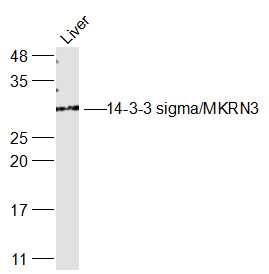
Rabbit Anti-14-3-3 sigma antibody
14 3 3 protein sigma; 14-3-3 protein sigma; 1433S_HUMAN; Epithelial cell marker protein 1; Er; HME 1; HME1; MGC143283; Mkrn3; Mme1; OTTHUMP00000004242; RP23 137L22.11; SFN; SFN protein; Stratifin; YWHAS.
View History [Clear]
Details
Product Name 14-3-3 sigma Chinese Name 14-3-3 sigma抗体 Alias 14 3 3 protein sigma; 14-3-3 protein sigma; 1433S_HUMAN; Epithelial cell marker protein 1; Er; HME 1; HME1; MGC143283; Mkrn3; Mme1; OTTHUMP00000004242; RP23 137L22.11; SFN; SFN protein; Stratifin; YWHAS. literatures Research Area Cell biology Chromatin and nuclear signals Neurobiology Signal transduction Stem cells transcriptional regulatory factor Immunogen Species Rabbit Clonality Polyclonal React Species Human, Rat, (predicted: Mouse, Dog, Pig, Horse, Rabbit, Sheep, ) Applications WB=1:500-2000 ELISA=1:5000-10000 IHC-P=1:100-500 IHC-F=1:100-500 ICC=1:100-500 IF=1:100-500 (Paraffin sections need antigen repair)
not yet tested in other applications.
optimal dilutions/concentrations should be determined by the end user.Theoretical molecular weight 28kDa Cellular localization The nucleus cytoplasmic Secretory protein Form Liquid Concentration 1mg/ml immunogen KLH conjugated synthetic peptide derived from human 14-3-3 sigma: 101-200/248 Lsotype IgG Purification affinity purified by Protein A Buffer Solution 0.01M TBS(pH7.4) with 1% BSA, 0.03% Proclin300 and 50% Glycerol. Storage Shipped at 4℃. Store at -20 °C for one year. Avoid repeated freeze/thaw cycles. Attention This product as supplied is intended for research use only, not for use in human, therapeutic or diagnostic applications. PubMed PubMed Product Detail 14-3-3 proteins regulate many cellular processes relevant to cancer biology, notably apoptosis, mitogenic signaling and cell-cycle checkpoints. Seven isoforms, denoted 14-3-3 b, g, e, z, h, q and s, comprise this family of signaling intermediates. 14-3-3 s, also known as SFN, stratifin, HME1 or YWHAS, is a secreted adaptor protein that is involved in regulating both general and specific signaling pathways. Expressed predominately in stratified squamous keratinising epithelium, 14-3-3 s is able to bind and modify the activity of a large number of proteins, such as KRT17 (Keratin 17), through recognition of a phosphothreonine or phosphoserine motif. When bound to Keratin 17, for example, 14-3-3 s acts to stimulate the Akt/mTOR signaling pathway by upregulating protein synthesis and cell growth. 14-3-3 s also functions to positively mediate IGF-I-induced cell cycle progression and can bind to a variety of translation initiation factors, thus controlling mitotic translation. In response to tumor growth, 14-3-3 s positively regulates the tumor suppressor p53 and increases the rate of p53-regulated inhibition of G2/M cell cycle progression. Multiple isoforms of 14-3-3 s exist due to alternative splicing events.
Function:
Adapter protein implicated in the regulation of a large spectrum of both general and specialized signaling pathways. Binds to a large number of partners, usually by recognition of a phosphoserine or phosphothreonine motif. Binding generally results in the modulation of the activity of the binding partner. When bound to KRT17, regulates protein synthesis and epithelial cell growth by stimulating Akt/mTOR pathway.
p53-regulated inhibitor of G2/M progression.
Subunit:
Homodimer. Interacts with KRT17 and SAMSN1 (By similarity). Found in a complex with XPO7, EIF4A1, ARHGAP1, VPS26A, VPS29, VPS35 and SFN. Interacts with GAB2. Interacts with SRPK2. Interacts with COPS6. Interacts with RFWD2; this interaction leads to proteasomal degradation.
Subcellular Location:
Cytoplasm. Nucleus. Secreted. May be secreted by a non-classical secretory pathway.
Tissue Specificity:
Present mainly in tissues enriched in stratified squamous keratinizing epithelium.
Similarity:
Belongs to the 14-3-3 family.
SWISS:
P31947
Gene ID:
2810
Database links:Entrez Gene: 2810 Human
Entrez Gene: 55948 Mouse
Omim: 601290 Human
SwissProt: P31947 Human
SwissProt: O70456 Mouse
Unigene: 523718 Human
Unigene: 44482 Mouse
Product Picture
Bought notes(bought amounts latest0)
No one bought this product
User Comment(Total0User Comment Num)
- No comment



 +86 571 56623320
+86 571 56623320
 +86 18668110335
+86 18668110335

